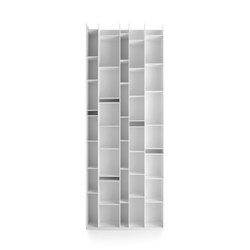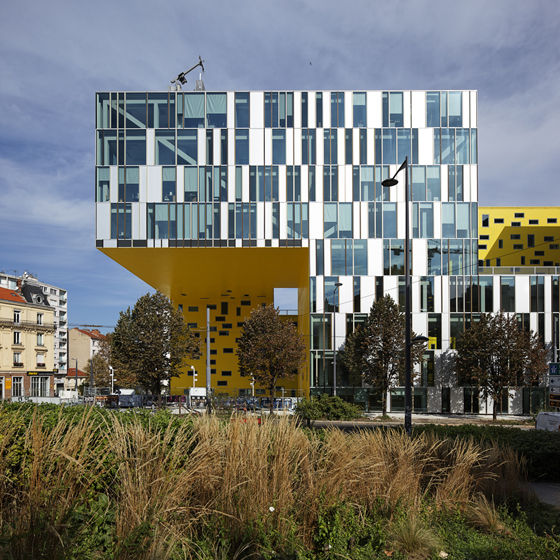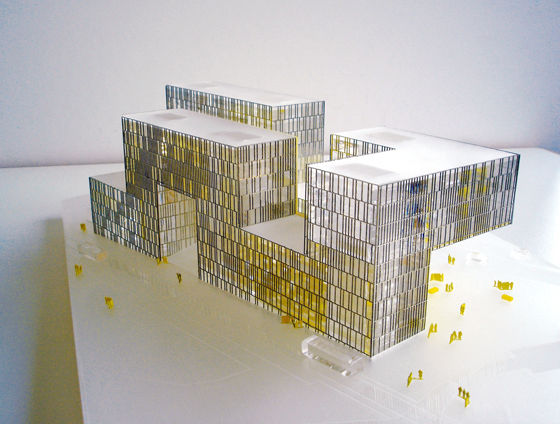The site is a vital liaison point between the centre of Saint-Etienne and the new Chateaucreux neighbourhood, to which it forms a major entranceway. It also constitutes a pole grouping several government bodies that will set up there : Regional Development Authority, Tax Services, Epora, Saint-Etienne Métropole, and so on. Service and leisure facilities will also be part of the mix: shared corporate restaurant, café, tourism bureau for the metropiltan area.
The idea is to develop a long built ‘continuum’ on the site to interact with adjacent streets. A linear construction that rears up and unfolds but also hugs the ground line to form a low accessible building - one that opens spacious courts and lifts bold overhangs.
Each of its large bays serves an access route: the main portal opens to the concourse on avenue Grüner, which draws pedestrians into the project in a sliding movement. A high ceiling shelters and magnifies this entranceway, which is the finest and largest of three. The other two large ‘ports’ open the project to the streets that irrigate the lot, interconnecting pedestrian itineraries in the area.
Our desire for continuity in construction does not simply reflect the idea of building a legible and unitary urban landmark, it also provides the flexibility that the project needs. In fact, the principle behind this continuum is to imagine a set of ‘communicating parts’ that enable the user-administrations to merge into a whole, one and all, and to evolve according to their needs in harmony with those of other tenants. The absence of breaks in surfaces will ensure that things remain open-ended, with the possibility of extending or reducing space.
The project is like a large ‘Aztec serpent’ rising on the lot. Its body has three identical outer faces, and an underside that is different: a skin of silvery transparent scales and a bright yellow ‘throat’, shiny and opaque.
This dual treatment of surfaces obeys a simple logic shared throughout, which aims at expressing clarity in folds. Depending on these movements, the yellow underside is either a floating canopy or an interior vertical wall, accompanying internal pedestrian movements with its rich luminous presence. The nearness of so much gorgeous yellow brightens up pavements and glazed elevations, casting golden washes over them like sunlight…This is a project that is about bringing together yellow and grey, silver and gold.
GENERAL DESCRIPTION OF THE BUILDING
The building superstructures volume is a parallelepiped, almost rectangle (length: 108m, width: 43m, max height: 34m).
This parallelepiped is hollowed out by the following:
• roofing-terraces at different levels
• interior pedestrianized street creating two access to the adjacent streets and a large parvis
• two porches surmounting two access (width : 20 sqm), from the ground level to the third floor for one and to the fourth floor for the other one
The result is a catalogue of different joined building’s parts and spread out by the following:
• building’s parts based on substructures, with a high from the third to the ninth level
• bridge building’s parts over the porches (width: 20 sqm)
• cantilever building’s parts surmounting the parvis (25 m X 20 m without any grounding)
SUPERSTRUCTURE PRINCIPLE
We can observe 3 structural principles even if we thought the building like a visual continuum:
- building’s parts based on substructures
- bridge building’s parts
- cantilever building’s parts
Building’s parts based on substructures :
The framework of these building’s parts is in reinforced concrete; it is made up of vertical circulations (staircases, elevators, ducts) and of floorboard with a ‘posts-beams’ framework .
Bridge building’s parts:
The framework of these two bridge building’s parts is made up of two principles:
• the inferior level guarantees the structural facility by the weight crossing over the porches, thanks steel mesh beams stayed with a system of built-in knots.
The up and down floorboards are made up of steel joists joined to a reinforced concrete stone and rest on the four steel mesh beams.
• the superior level is made up of post and beams in reinforced concrete, the posts resting on steel mesh beams of the bridge’s inferior level.
Cantilever building’s parts:
The framework of the cantilever is made up of a steel structure and floorboards joined to a reinforced concrete board on steel joists.
The steel framework guarantees the cantilever’s rigidity for its two directions and the weight transfer towards the reinforced concrete cores of the building’s parts resting on the substructures.
The vertical gravitational efforts of the cantilever framework are made up by:
• transmitted sloping compressions to the supporting walls on the side of the cantilevers with small beams,
• transmitted horizontal pulls by beams in the floorboards thickness with reinforced concrete cores
These cores guarantee the general stability of the building thanks the remoteness of the cantilever framework’s gravitational impact compared its foundations.
Steel triangulation elements complete the system in the floorboards to guarantee the cantilever framework’s rigidity.
Altarea-Cogedim
Manuelle Gautrand Architecture
Manuelle Gautrand, representative architect,
Thomas Daragon, works project manager, Yves Tougard, studies project manager
Structure: Khephren
Façade: Arcora
Maîtrise d’œuvre d’exécution : Debray Ingénierie
Roofing / Finishings: Pitance-Lamy
Metallic framework : Baudin-Châteauneuf
Façade : Allouis











































